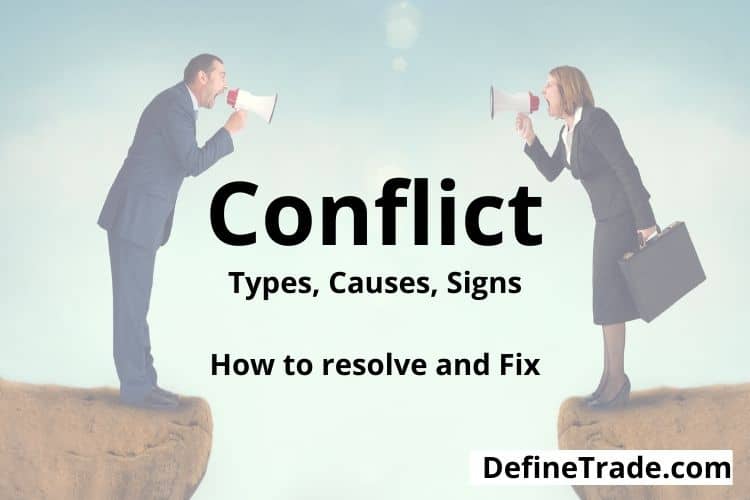Conflict in business Workplace Signs 10 Causes Types

Conflict can be defined as a disagreement between two or more people or groups. It can arise in any area of life, including business. In most cases, conflict is not good for anyone involved. It can lead to tension and hostility, and it can disrupt workflow and productivity.
Types of Conflict
There are several different types of conflict that can occur in a business setting. These include:
- Interpersonal conflict: This occurs when two or more people have a disagreement or argument. It can be caused by a variety of factors, including personality clashes, different opinions on how to do something, and disagreements about priorities.
- Group conflict: This type of conflict takes place when two or more groups within a company have disagreements about goals, strategies, or the best way to achieve results.
- Organizational conflict: This happens when there is a conflict between different parts of an organization, such as departments or branches. It can be caused by things like different goals, different ways of doing things, and power struggles.
conflict is not always a bad thing. In some cases, it can lead to positive outcomes, such as creativity and new ideas. However, conflict often has negative consequences, such as decreased productivity and employee morale. Therefore, it is important for businesses to try to resolve conflict in a constructive way.
How to deal with Conflict in the Business workplace
Some common methods include:
- Communication: This is often the first step in resolving conflict. Communicating openly and honestly can help to identify the root of the problem and find a solution.
- Negotiation: This involves discussing the conflict and trying to reach an agreement that everyone can live with. It can be helpful to have a third party mediator to help guide the negotiation process.
- Problem-solving: This involves analyzing the conflict and coming up with a plan to resolve it. It requires cooperation from all parties involved.
- Mediation: This is a process where a neutral third party helps to resolve conflict. The mediator does not take sides but instead helps the parties involved to come to a resolution.
- Conflict can be a difficult thing to deal with, but it is important to remember that there are often ways to resolve it peacefully and constructively. By using the methods described above, businesses can minimize the negative effects of conflict and continue to operate productively.
Signs of conflicts in work place-increased absenteeism
- Lowered productivity
- More sick days
- Employees leaving the company
- Hostility between coworkers
- Tension in the office
- Mistrust among employees
- Negativity in the work environment
- Disruptions in workflow
- Decreased morale
How to resolve the conflict in management
- Open communication is key. Talk to your employees, listen to their concerns, and be willing to compromise.
- Make sure that everyone has a clear understanding of the company’s goals and objectives.
- Encourage teamwork and cooperation.
- Set realistic deadlines and expectations.
- Use conflict resolution techniques, such as negotiation and problem-solving.
- Be willing to mediate if necessary.
- Create a positive work environment where conflict is less likely to occur.
What are the Causes of Conflict in the workplace?
The causes of conflict in the workplace can be varied and complex. In most cases, it is caused by a combination of factors. Some common causes of conflict include:
- Different goals and objectives: When employees have different goals and objectives, it can lead to conflict. For example, if one employee wants to focus on profits, and another wants to focus on customer service, they may conflict over the best way to achieve results.
- Different ways of doing things: When employees have different methods of doing things, it can lead to conflict. For example, if one employee prefers to work independently, and another prefers to work in a team environment, they may conflict over the best way to get work done.
- Power struggles: When employees feel like they are competing for power, it can lead to conflict. For example, if one employee feels like they are more qualified for promotion than another, they may conflict over who should get the job.
- Personality differences: When employees have different personalities, it can lead to conflict. For example, if one employee is outspoken and aggressive, and another is quiet and passive, they may conflict over the best way to handle situations.
- Ethical differences: When employees have different ethical beliefs, it can lead to conflict. For example, if one employee believes that it is acceptable to cut corners in order to increase profits, and another employee believes that it is important to always operate ethically, they may conflict over the best way to do business.
- Racism or sexism: When employees display racist or sexist attitudes, it can lead to conflict. For example, if one employee makes racist jokes, or if one employee refuses to work with a certain group of people, it can lead to conflict.
Conflict in the workplace is often caused by a combination of factors. Some common causes include different goals and objectives, different ways of doing things, power struggles, personality differences, ethical differences, and racism or sexism. By understanding the causes of conflict, businesses can be better prepared to deal with it when it arises.
Conflict resolution and its types
conflict resolution is the process of resolving conflict in a peaceful and constructive manner. There are many different methods of conflict resolution, but some common ones include negotiation, mediation, and arbitration.
- Negotiation is a method of conflict resolution where parties try to reach an agreement by discussing their differences and coming to a compromise.
- Mediation is a method of conflict resolution where a third party helps the parties to reach an agreement.
- Arbitration is a method of conflict resolution where a third party hears the arguments from both sides and makes a decision that is binding on both parties.
